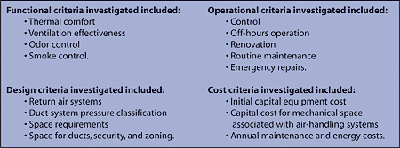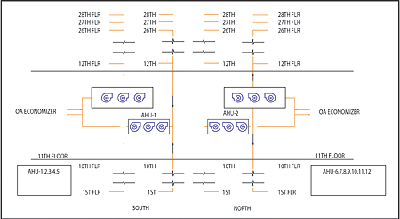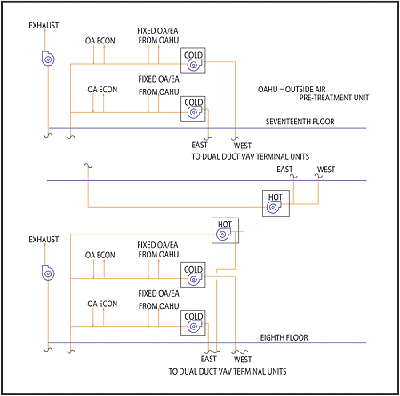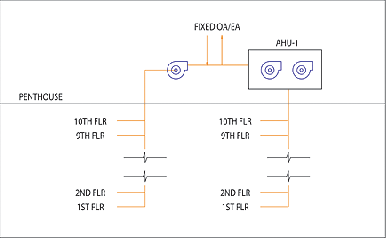
The study's objective was to develop the criteria for configuration and sizing of AHU systems in the GSA's Facilities Standards for the Public Building Service (PBS-P100). The study demonstrated that a decentralized air-handling system utilizing small AHUs is the optimal configuration for federal buildings for a number of reasons, including better functionality, better operations, and decreased life cycle costs.

The ‘Central' Issue
In the study, five newly constructed federal facilities were evaluated and energy simulations were performed to address both new construction and renovation projects. The facility sample included U.S. federal courthouses and federal office buildings since these two types of buildings sufficiently characterize the bulk of the GSA inventory. The particular buildings were selected because they were previously analyzed in post occupancy evaluations to help GSA assess customer satisfaction.
The study focused on the issue of centralization. The buildings were labeled as centralized (containing large air-handling systems) or decentralized (containing small air-handling systems) by the 2000 ASHRAE Handbook - Systems and Equipment, definition of large air-handling systems as those over 50,000 cfm in capacity. ASHRAE explains that the dividing line is at or near 50,000 cfm because at this capacity, AHU equipment is usually custom-designed rather than off the shelf.

The Buildings Surveyed
Ralph H. Metcalfe Federal Building, Chicago.The 736,000-sq-ft, Ralph H. Metcalfe Federal Building, completed in 1991, is placed prominently in the Chicago Federal Center. The building is served by the two main 275,000-cfm AHUs. Each AHU is equipped with an airside economizer for free cooling when the ambient conditions are favorable. Secondary air distribution is accomplished by fan-powered VAV terminal units.The Metcalfe Building is also equipped with a nonintegrated control system that provides minimal energy savings. GSA's primary issue with the system is off-hours operation. It is not possible to operate the HVAC system for a single floor during off hours because the air handler's minimum fan speeds exceed the airflow requirements. This effectively restricts GSA from leasing space in the building to tenants that require 24-hr air conditioning accommodations.
Mark O. Hatfield U.S. Courthouse, Portland, OR. The 573,000-sq-ft, Mark O. Hatfield U.S. Courthouse, completed in 1997, is located in Portland's downtown government center. The HVAC system includes six large AHUs in a dual duct arrangement with mixing boxes in the spaces. Two 120,000-cfm AHUs provide cooling for the upper floors while two 110,000-cfm AHUs serve the lower floors. There are also two 100,000-cfm AHUs that provide heating to perimeter zones. Outside air is provided to the cooling-only AHUs through four outside air pretreatment AHUs. The cooling AHUs are equipped with airside economizers. The building has a fully integrated BAS using a DDC system. As with the Ralph H. Metcalfe Federal Building, off-hours operation of a single floor requires operation of the entire air-handling system.
Bruce R. Thompson U.S. Courthouse, Reno, NV. The 197,000- gross-sq-ft, Bruce R. Thompson U.S. Courthouse, is a 10-story building housing six courtrooms organized around a central core. The air distribution system is comprised of one 170,000-cfm air handler with a fixed amount of outside air. Supply air is ducted vertically in the central core to feed all floors of the building. The air-handling system is VAV with terminal air units in the spaces. The central AHU is equipped with a waterside economizer coil for free cooling. The constant volume outside air pretreatment AHU includes exhaust air heat recovery. The courthouse also utilizes a DDC system with minimal energy saving control strategies. Again, off-hours operation of a single floor requires the operation of the entire air-handling system.
Glenn Anderson Federal Building, Long Beach, CA. The 275,000-gross-sq-ft, Glenn Anderson Federal Building, which opened in 1991, is located in a redevelopment area of downtown Long Beach, CA. Each floor consists of two mechanical rooms housing two AHUs each. One of the AHUs provides heating only for the perimeter spaces (3,800 cfm each) and the other provides cooling only for perimeter and interior spaces (ranging from 13,000 to 16,000-cfm/AHU). Each cooling-only AHU has an integrated airside economizer, which reportedly operates nine months out of the year. Secondary air distribution is accomplished by dual duct VAV terminal units. The building also utilizes an integrated DDC system and off hours operation is easily accomplished with the small AHUs.
U.S. Courthouse, Minneapolis. The 15-story, 465,000-gross-sq-ft U.S. Courthouse is located in the downtown business district of Minneapolis. The building's air-handling system includes many of the new PBS-P100 criteria such as no AHU exceeding 25,000 cfm. The building is served by 50 floor-by-floor AHUs and two outside air pretreatment AHUs. The podium and the office areas in the tower are served by VAV AHUs that feed parallel fan-powered terminals with hot water reheat. Multizone units, with two-speed motors serve the courtroom spaces in the tower element. The AHUs vary in size from 8,000 to 14,000 cfm. The building also utilizes a state-of-the-art DDC system and off-hours operation is easily accomplished with the multiple small AHU design.

Defining Performance
The site surveys took place over several days and included interviews with on-site O&M personnel, examination of air-handling systems, and measurement of critical parameters in selected spaces. The interviews included building managers, operating engineers, and technicians. Discussions included the range of daily maintenance issues, long-term issues, and functionality.
The results of the surveys and simulations were then analyzed. Although many of the evaluation criteria were subjective in nature, they proved to be helpful in defining GSA's position. The criteria were divided into four categories: functional, operational, design, and cost. A summary of the findings for each category is provided in Table 1.
Functional Analysis
The two functional evaluation criteria that were strongly affected by the centralization issue are ventilation and odor control. The quantities of ventilation air required per code differ depending on the size of the AHU. This relationship can be determined by using the multiple spaces method in Section 6.1.3.1 of ASHRAE STD 62-1999.
The results of the multiple space calculations conclude that the amount of total system outside air for one large AHU is greater than the sum of multiple system quantities of outside air for multiple small AHUs. This is because federal buildings, especially courthouses, have largely varied occupancies with high concentration areas such as assembly areas like courtrooms. The second differentiating factor is the reduction in odor control and compartmentalization inherent to centralized systems because return air streams from multiple floors and spaces are mixed at the large AHUs.

Operational Analysis
All of the operational evaluation criteria were directly influenced by centralization. Beginning with controls, it was observed that the large AHU systems, although containing less equipment to control, were less flexible in the operational setpoints. Building operators were reportedly satisfied with small AHU systems that allow for different operational parameters for various spaces. As previously mentioned, the lack of off-hours operation with large AHU systems was an important issue for GSA, considering the number of individual tenants in large federal buildings.
The ability to renovate federal buildings is critical because of the expected life span of 50 to 100 years. The smaller AHU systems are advantageous because the renovations can proceed in phases over time without disruption to the entire building. Routine maintenance as defined by the GSA Preventive Maintenance Guide Standards is the one operational criterion that benefits buildings with large AHUs. With less equipment to maintain, routine maintenance is faster and less expensive. However, when emergency repairs are required, having smaller, off the shelf, equipment is advantageous. For instance, the downtime associated with replacing large-horsepower motors in AHUs that serve an entire building is extremely costly.

Design Impact Analysis
The design evaluation criteria focus on those portions of the air-handling system that affect the design of the building. Specifically, the GSA felt that the potential reduction in return air ductwork and fans and the reduced noise levels were favorable in the small AHU systems. It was also determined that AHU capacity did not have an appreciable effect on the space required for supply air ductwork, external environmental security, zoning, or amount of mechanical space required.
Equipment Cost Analysis
The cost of each HVAC system varied based on climate, location, market, and design. Therefore, it was determined that isolating equipment costs was the best method for evaluating capital cost. Major manufacturers of air-handling equipment provided pricing based upon a cost per cfm. The manufacturer's cost does not include installation or contractor's overhead and profit. The purchase price from the factory includes a basic air handler with prefilters, 65% filters, cooling coils, and a supply fan. Modular factory fabricated units (small AHUs) cost approximately $2/cfm at the smallest (1,500 cfm) size and the cost gradually decreases to $0.70/cfm at the largest standard size (50,000 cfm). Similarly equipped larger units are custom factory fabricated and cost about $3 to $4/cfm.Energy Costs Analysis
In order to predict the effect of centralization on annual energy costs for all 11 regions of the GSA, a series of 22 DOE-2 simulations were run. The energy analysis was based on a typical 500,000 gross sq ft, 10-story, federal building modeling using the prescriptive requirements in the ASHRAE Standard 90.1 energy cost budget method, 10CFR434, and 10CFR435. The small AHU model included two AHUs per floor with a capacity of 25,000-cfm each designed for 4.0-in. wc total pressure. The large AHU model included three AHUs with a capacity of 150,000 cfm each designed for 6.5-in. wc total pressure (reduction in total capacity accounted for by diversity). The parameters, which varied, were the AHU capacity, static pressure, location, weather data, and utility costs. Additionally, the simulations were run assuming one floor of the building remained occupied for 24/7. Finally, all of the results were normalized such that the average of all 11 regions met the total inventory goal of 55,000-Btu/sq ft/yr (Table 2).
Conclusion
The matrix in Table 3 provides a summary of the comparative results of the study. The results show that the small AHU systems prevailed in 13 out of 21 evaluation criteria.Based on the results of the study it was determined that decentralized small AHU systems are preferred for new federal office buildings and courthouses as well as major federal building renovations. The advantages of using this type of system can be seen through improvements in functional performance, operational performance, capital cost savings, annual cost savings, and ultimately better customer satisfaction. ES
